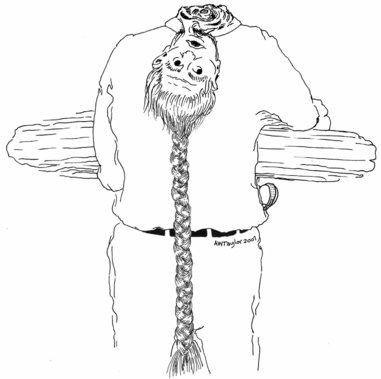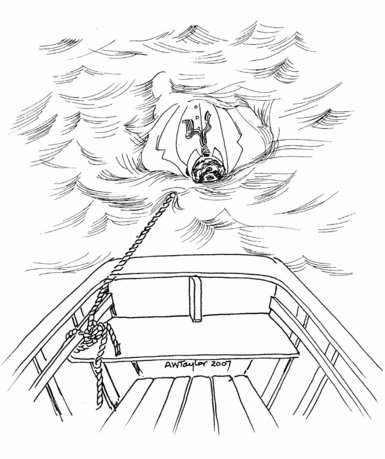The Golden Leg (8 page)
Authors: Dale Jarvis


W
hen the following incidents occurred
exactly, I cannot say, but I can assure you that they were related to me as a
true tale. The story goes that in a certain place not too far from here, a ghost
suddenly started to haunt a location where a ghost had never been seen before.
Travellers coming home late at night were terribly frightened by the ghoulish
apparition, for it was a truly unusual figure, even for a ghost.
The ghost appeared to make good progress, even over rough ground. It moved with
a peculiar gliding motion. The strange movement could be explained perhaps by
the fact that the phantom was completely legless. It was headless as well. Or
perhaps more properly, it could be described as partially headless, for its head
hung down its back between the shoulders, its eyes staring out behind. From its
head sprouted one long pigtail, tarred black, a pigtail so long that it trailed
along on the ground.
In its arms, the figure carried a long bundle wrapped up in some sort of
fabric. It seemed to be the ghost of a sailor, as it was dressed in a dark-blue
uniform which was the fashion
among seagoing men in those days.
Around its waist it wore a broad leather belt with a large brass buckle and a
pistol thrust into it, all a-twinkle in the moonlight.

After several people were frightened close to death by this horrible spectre,
one man, more brave, or perhaps more foolish, than the rest, decided that he
would follow the creature. He waited one night for the ghost to appear, and when
it did, the man followed it with quaking steps.
Although its head was upside down and looking the
other
direction, the ghost still seemed to know precisely where it was going. The man
followed along behind, and tried to stay out of sight of those awful, staring
eyes. He crept along as the ghost glided down the path until it came to an old
well.
There it stopped, balanced the long bundle in its arms, and then dropped it,
short end first, down into the well. The phantom sailor then hovered aimlessly
around the circumference of the well for some time. It then sat on the edge of
the well, paused for a moment, and fell backward, vanishing after the mysterious
bundle down into the well.
The next day, the man shared his story with his family and friends. He was
laughed at by many who heard the story. But the man insisted he was telling the
truth, and that he had indeed followed the ghost as he had described.
Eventually, it was decided the only way to get to the bottom of the case was to
get to the bottom of the well.
The townspeople gathered around the mouth of the well, armed with ladders and
rope. A volunteer was found to make the journey down into the dark depths, and a
loop was tied in a long length of rope. The young man climbed into the loop, and
then was slowly lowered down into the blackness, a small lantern providing him a
bit of light.
Down went the young man, twenty feet, then thirty, then forty. He could see
nothing that might explain the haunting, so he hollered up the shaft to be
brought back up. As the men above started to haul him upward, a fragment of blue
cloth snagged on a projecting brick caught his eye.
Once he reached the surface, the piece of fabric was passed
around, and it was agreed that the young man should be sent back down into the
well. So he was, armed with a long stick, and when he reached the bottom, he
began to probe the inky blackness of the water at the very bottom of the
well.
Anxious moments followed, the curious spectators at the top of the well not
knowing what was transpiring below.
“I can feel something soft at the bottom,” came the young man’s voice out of
the gloom, echoing in strange tones up the dank well-shaft.
A long iron hook was quickly tied to an old clothesline, and lowered down to
the lad. After a while, he succeeded in hooking into something under the water,
and shouted to be lifted out. The men set to work again, hauling up the young
man. Once he was out, they hauled up the clothesline, hand over hand.
At the end of the clothesline was the old iron hook, and at the end of the hook
was a waterlogged sack, firmly tied shut with twine. The twine was cut, the
mouth of the sack was opened, and the bag was then upended.
The contents came tumbling out onto the ground, and the assembled crowd drew
back, as the items turned out to be the two legs of a man, hacked off roughly
midway up the thighs.
At this, the searchers were more convinced than ever that the solution to the
mystery could be found at the bottom of the well. The boy, however, got such a
fright at the sight of
the mutilated legs that he refused to go
back down. A second volunteer, after he was given a drink to bolster his
courage, agreed to make the journey.
Like the boy before him, the man was lowered down into the well with the iron
hook. When he reached the bottom, he set to work, dipping the hook down into the
black water in search of answers. Those who gathered around the edge of the well
could see him probing the depths of the well, but without any success.
At last, just as they were about to give up hope, the man shouted out that he
had found something, but that it was quite heavy. He tried to jerk it up with
the hook, but as he did so, his lantern slipped from his grasp, leaving him in
absolute darkness. Determined not to lose what he had found, the man thrust his
arms down into the cold wetness, grabbed hold of the object, and yelled to be
brought up.
The villagers hauled at the ropes, and before too long, the man appeared,
bearing in his arms a large mass of what looked like wet clothing. Once free of
the well, the man dumped his burden onto the ground and turned it over.
Much to the shock of the crowd, the sodden mass was revealed to be the
decomposing body of a stranger. The man’s head sported a long, dark pigtail, but
the head itself was only attached to the body by a thin strip of skin at the
back of the neck.
The figure’s legs had been removed. What was left of the body was wearing a
wide leather belt with a large brass buckle, and in the belt was thrust a
flintlock pistol. It was
dressed in the torn blue outfit of a
sailor, and in all regards was identical to the spectral form described by the
man who had followed the ghost the night before.
A few weeks later, evidence was found that the sailor had been murdered in a
barn nearby. A large patch of blood was found, and a matching pistol was
discovered hidden in the hay. Three gold pieces were found trampled into the
earth, and it was supposed the sailor had been attacked and murdered for his
money. In order to make the corpse easier to carry, the murderers had hacked off
his legs, and then had dumped them, and the body, down into the well.
The murderers were never found, nor brought to justice. The ghost of the
unfortunate sailor, forever in search of his unpunished murderers, can still be
seen gliding through the night from time to time. He still cradles in his arms
the sack containing his legs, with his head rolled back and resting between his
shoulder blades, and his horrible, staring eyes gazing out behind for
eternity.

A
long time ago, two hundred years at
least, there lived a rich squire. The squire lived in great comfort in a large
country manor named Harnage Grange with his wife and his family. The squire had
several children, but the one he loved dearest was his eldest daughter,
Margaret.
Margaret’s beauty was famed throughout that part of England. Her skin was as
pale as milk, and her hair was as red as flame. Margaret had many suitors, but
only one of them captured her heart. She consented to be his wife, and a day for
the wedding was set.
The young couple were due to marry at nearby Langley Chapel. On the day of the
wedding, the squire of Harnage Grange had his best horses harnessed to his
finest carriage. He held out his hand to his daughter, and helped her up into
the carriage, gathering up her long white train and arranging it
carefully.
Off they set, the driver keeping the spirited horses at a steady pace. As they
approached the bridge at Harnage Ford, something spooked the horses, and they
bolted, swerving and
galloping off the road and down the hill
toward the rushing river. The wedding carriage shuddered and bounced, and as the
horses neared the water, they tried to pull away.
The sudden movement was too much for the carriage. One of the great wheels
struck a rock and splintered at the sudden impact. The carriage rolled over,
throwing the squire and Margaret clear, but it landed on top of one of the
horses, knocking it into the river. The beast neighed in terror, and thrashed
about, but unable to get clear of the wreckage, it drowned in the swift running
water.
The bride’s father pulled himself up to his knees and crawled to where his
daughter lay senseless on the riverbank, her long white dress spattered with
muddy earth and stained with blood. He lifted Margaret up in his arms, and
carried her back to Harnage Grange, her long white train trailing in the earth
behind them. The squire survived to tell the tale, but Margaret, sadly, died of
her injuries a short time later.
Langley Chapel fell into disrepair in the early 1800s, but the story of the
terrible tragedy that occurred nearby refused to die. The tale of Margaret who
perished on her wedding day was told over and over, and Harnage Ford soon
acquired a rather eerie reputation.
Two hundred years later, the spirits of both Margaret and the horse that
drowned in the river are still said to haunt Harnage Ford. Even today, horses
insist on stopping every time they reach the ford, and are often reluctant to
cross the bridge. It is said by some that those horses can see what we
humans cannot—the ghostly remains of Margaret with her
milk-white skin, her long white dress, and hair as red as flame, standing beside
a stately phantom horse on the banks of the rushing river.

E
verything about Joseph’s day had been
grey. The sky was like worn flannel, and the ocean that rolled underneath it was
much the same. Even Joseph’s mood was grey; all day long his nets had come up
empty.
Joseph placed the oars in their oarlocks, and started to row to where his next
net was set. There was a slight swell on the water, and as he rowed along, he
thought of his wife, and their six children. He thought of the roof that needed
patching, and he thought of his poor luck that day.
“Well,” he said to himself, “it can’t get much worse.”
With that, he grasped at the next net, and for a moment, felt a surge of
optimism. The net was heavy. He shifted his weight in the boat, leaning back,
legs braced instinctively. Hand over hand he hauled the net into the boat.
As he did, he started to mutter under his breath. This net was empty as well,
but heavy, as if something had snagged in it. Joseph looked down into the
slate-grey waters, and could see a dark mass. He hauled it in closer, and felt a
great lump form in his throat.
Twisted into the netting was the body of a man. The skin was
bluish-grey, with long bare arms. The hands were rough and callused, the
fingernails short and broken, a working man’s hands, like his own. The body
still wore dark navy pants, though the boots had been lost and the toes had been
nibbled by the fish.
Joseph was something of a hard man. He had seen a lot in his day, had gutted
more fish than there were stars in the sky, had seen friends lost to the sea and
family lost to wasting sickness. But nothing had prepared him for what he hauled
up in the net that day. For the man in his net was missing its head, the edges
of the neck ragged and torn.
For a moment he sat there, the only motion the rise and fall of the water, the
headless corpse half in, half out of his boat and still tangled in the web of
his nets. Finding a body like that, waterlogged, fish-nibbled, headless . . .
that was not something any man would want in his boat. But at the same time, it
was not something you could exactly ignore, either.
Joseph freed the corpse from the nets, and tied a line under the man’s arms,
around his chest, securing the other end of the line to the boat. He set his
nets again, carefully. Then trying as best he could not to gaze upon that
frightful stump of a neck, he pushed the body of the man back into the water. He
fitted his oars into place, and started to row for home.
The line played out behind him, towing the body along. As he rowed, Joseph’s
eyes kept darting back along the line, to
where the headless man
could be seen, bobbing along. Joseph shivered, unable to shake the impression
that the corpse was swimming after him.
By the time he reached the shore, Joseph was ready to be rid of his unusual
catch. He hove the boat up onto the beach, and reeling in the line, cast the
headless body up onto the shore. He looked down at it, uncertain what to do
next.
“I can’t leave him there,” thought Joseph. He reached down, picked up the
body, and slung it over his shoulder. Up the beach he went, the man’s cold, wet
arms dangling down Joseph’s back. He carried the body up to a large, flat rock,
near a place known as the Spring Well. He laid the body down on the rock, and
then went to find help.
Joseph’s feet flew over the rocks as he ran into the town, shouting out for
help. A few men gathered at the sound of his voice, and Joseph told them all
what he had hauled up out of the ocean’s deep. The men agreed to go back to the
Spring Well with him, and together they would bury the body in the
churchyard.
When the men returned to the Spring Well with Joseph, they all stopped and were
silent. All eyes looked at the rock, and then questioningly turned back to
Joseph. The rock was empty, and the headless body had vanished completely.
This happened a long time ago. But there are those, to this day, who say that
the body can sometimes be seen on cold windy nights. It is said to return to the
spot known as the Spring Well, forever searching for its missing head.

